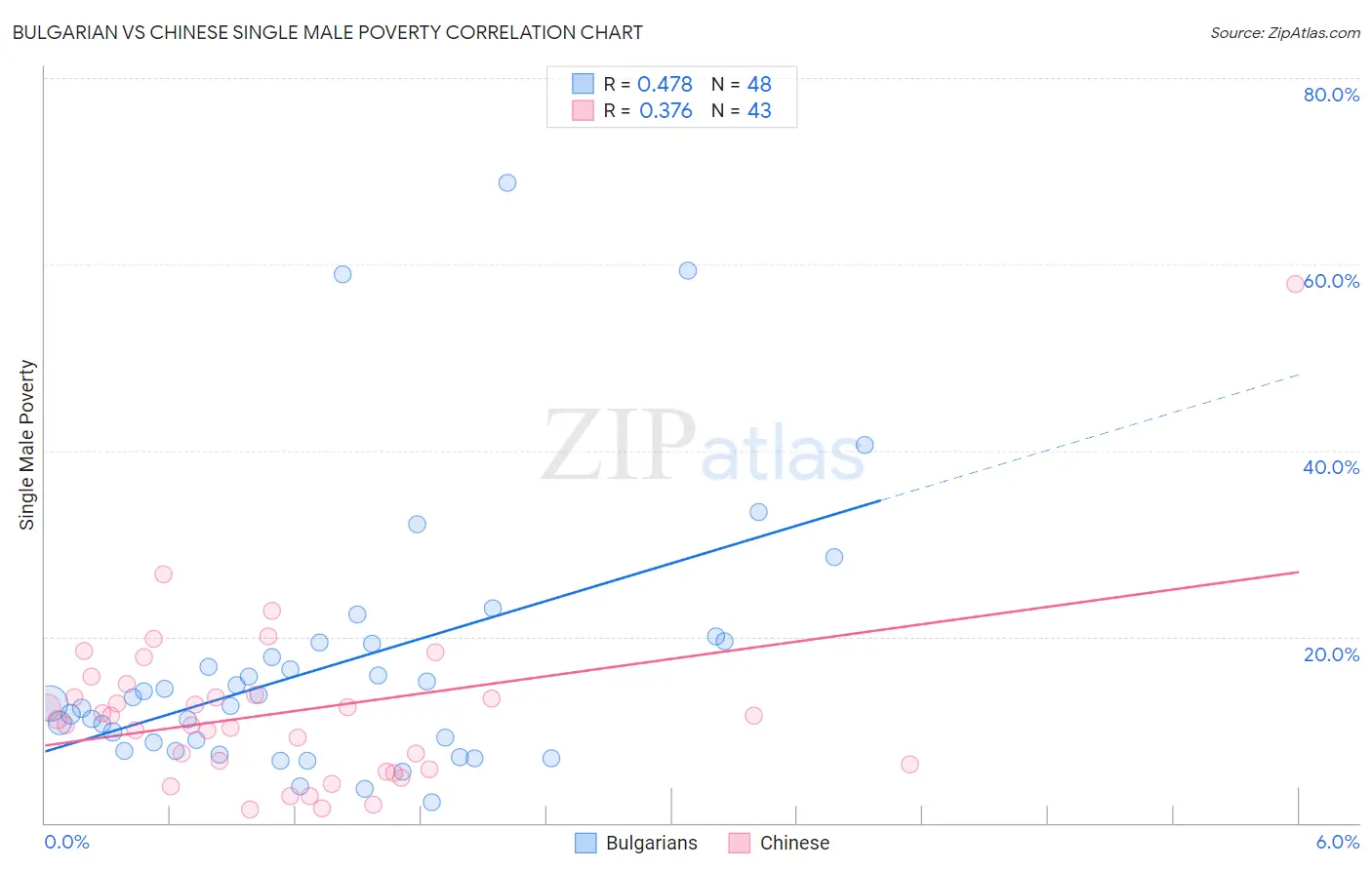Bulgarian vs Chinese Single Male Poverty
COMPARE
Bulgarian
Chinese
Single Male Poverty
Single Male Poverty Comparison
Bulgarians
Chinese
11.7%
SINGLE MALE POVERTY
99.9/ 100
METRIC RATING
53rd/ 347
METRIC RANK
11.0%
SINGLE MALE POVERTY
100.0/ 100
METRIC RATING
14th/ 347
METRIC RANK
Bulgarian vs Chinese Single Male Poverty Correlation Chart
The statistical analysis conducted on geographies consisting of 188,709,586 people shows a moderate positive correlation between the proportion of Bulgarians and poverty level among single males in the United States with a correlation coefficient (R) of 0.478 and weighted average of 11.7%. Similarly, the statistical analysis conducted on geographies consisting of 62,746,830 people shows a mild positive correlation between the proportion of Chinese and poverty level among single males in the United States with a correlation coefficient (R) of 0.376 and weighted average of 11.0%, a difference of 6.2%.

Single Male Poverty Correlation Summary
| Measurement | Bulgarian | Chinese |
| Minimum | 2.3% | 1.5% |
| Maximum | 68.8% | 57.9% |
| Range | 66.5% | 56.4% |
| Mean | 17.0% | 11.9% |
| Median | 13.1% | 11.1% |
| Interquartile 25% (IQ1) | 8.2% | 5.7% |
| Interquartile 75% (IQ3) | 19.3% | 13.8% |
| Interquartile Range (IQR) | 11.1% | 8.1% |
| Standard Deviation (Sample) | 14.2% | 9.3% |
| Standard Deviation (Population) | 14.1% | 9.2% |
Similar Demographics by Single Male Poverty
Demographics Similar to Bulgarians by Single Male Poverty
In terms of single male poverty, the demographic groups most similar to Bulgarians are Immigrants from Uzbekistan (11.7%, a difference of 0.020%), Samoan (11.7%, a difference of 0.10%), Cypriot (11.7%, a difference of 0.19%), Paraguayan (11.6%, a difference of 0.41%), and Burmese (11.7%, a difference of 0.51%).
| Demographics | Rating | Rank | Single Male Poverty |
| Immigrants | Bulgaria | 99.9 /100 | #46 | Exceptional 11.6% |
| Nepalese | 99.9 /100 | #47 | Exceptional 11.6% |
| Immigrants | Indonesia | 99.9 /100 | #48 | Exceptional 11.6% |
| Tlingit-Haida | 99.9 /100 | #49 | Exceptional 11.6% |
| Immigrants | Lithuania | 99.9 /100 | #50 | Exceptional 11.6% |
| Paraguayans | 99.9 /100 | #51 | Exceptional 11.6% |
| Samoans | 99.9 /100 | #52 | Exceptional 11.7% |
| Bulgarians | 99.9 /100 | #53 | Exceptional 11.7% |
| Immigrants | Uzbekistan | 99.9 /100 | #54 | Exceptional 11.7% |
| Cypriots | 99.9 /100 | #55 | Exceptional 11.7% |
| Burmese | 99.8 /100 | #56 | Exceptional 11.7% |
| Immigrants | Romania | 99.8 /100 | #57 | Exceptional 11.7% |
| Immigrants | Brazil | 99.8 /100 | #58 | Exceptional 11.7% |
| Brazilians | 99.8 /100 | #59 | Exceptional 11.8% |
| Peruvians | 99.8 /100 | #60 | Exceptional 11.8% |
Demographics Similar to Chinese by Single Male Poverty
In terms of single male poverty, the demographic groups most similar to Chinese are Korean (11.0%, a difference of 0.050%), Immigrants from South Central Asia (10.9%, a difference of 0.57%), Immigrants from Afghanistan (10.9%, a difference of 0.69%), Immigrants from Philippines (10.9%, a difference of 0.76%), and Immigrants from Fiji (10.9%, a difference of 0.78%).
| Demographics | Rating | Rank | Single Male Poverty |
| Afghans | 100.0 /100 | #7 | Exceptional 10.7% |
| Thais | 100.0 /100 | #8 | Exceptional 10.8% |
| Taiwanese | 100.0 /100 | #9 | Exceptional 10.9% |
| Immigrants | Fiji | 100.0 /100 | #10 | Exceptional 10.9% |
| Immigrants | Philippines | 100.0 /100 | #11 | Exceptional 10.9% |
| Immigrants | Afghanistan | 100.0 /100 | #12 | Exceptional 10.9% |
| Immigrants | South Central Asia | 100.0 /100 | #13 | Exceptional 10.9% |
| Chinese | 100.0 /100 | #14 | Exceptional 11.0% |
| Koreans | 100.0 /100 | #15 | Exceptional 11.0% |
| Bhutanese | 100.0 /100 | #16 | Exceptional 11.1% |
| Tsimshian | 100.0 /100 | #17 | Exceptional 11.1% |
| Immigrants | Bolivia | 100.0 /100 | #18 | Exceptional 11.1% |
| Immigrants | Moldova | 100.0 /100 | #19 | Exceptional 11.2% |
| Ethiopians | 100.0 /100 | #20 | Exceptional 11.2% |
| Asians | 100.0 /100 | #21 | Exceptional 11.2% |